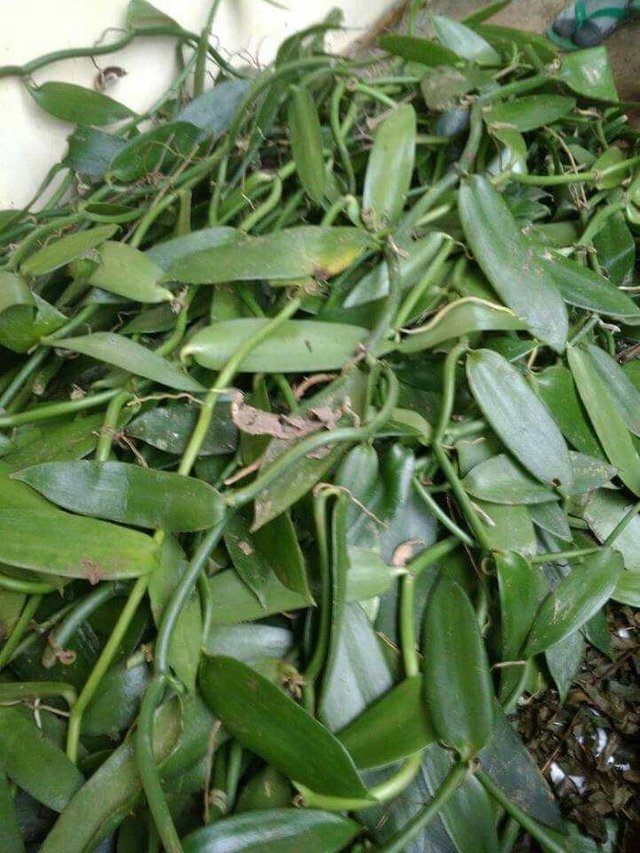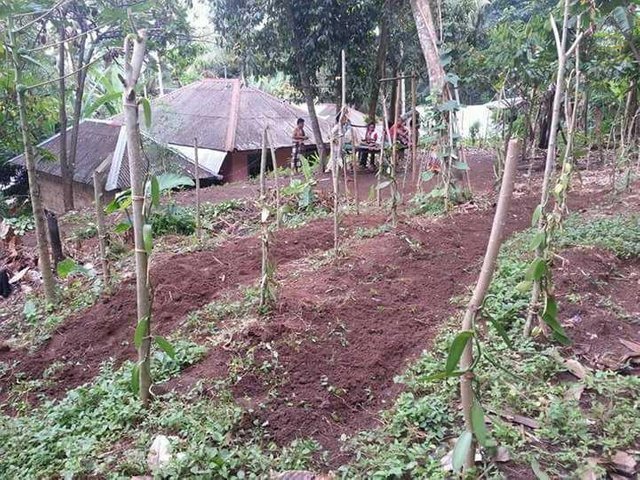Requirement of Growth of Vanilla Cultivation

Most of the vanilla growing areas in Indonesia are found in Java located between 50 L.U.- 70 L.S. Vanilla planting centers in Java are located in 3 places, namely Garut (West Java), Temanggung and Kedu (Central Java) and Malang and Banyuwangi (East Java). Climatic elements that affect much on the cultivation of vanilla plants is the elevation (high place) temperature, rainfall type and air humidity. Soil loose, light soil type sandy loam (sandy loam) and sandy loam gravel (gravelly sandy loam), easy to absorb water, soil pH + 5.7 - 7
BREAKING
Seed Selection
Type of economic valuable vanilla Vanilla planifolia Andrews, Vanilla tahitensis JW. Moore, Vanilla pompana. Generative seed requirements: genuine, have properties similar to the parent; pure, unmixed seeds with poor quality; seeds in fresh and healthy condition; vegetative seedlings: healthy and elderly parent plants, have issued strong tendrils, parent plants have not or not to bear fruit.Seed Preparation
Generative seeds are derived from superior seeds. Vegetative seedlings with cuttings, accelerate rooting of cuttings can be soaked HORMONIK (1-2 cc / liter) then left a little wilted new planted and watered POC NASA (2-3 ttp) + HORMONIK (1 ttp) 10 liters of water.Culture Network.Seed Seeding Technique
Seeds are sown in sandy soil for easy growing roots. The seeding place should be shaded.Nursery Maintenance / Seeding
Watering every day, should not be too wet. Poor seeds are removed. Once a week spray with POC NASA (2-3 caps) + HORMONIK (1 cap) per tank (14-17 liters).Seed Transfer
Transfer of seeds to the field depending on the origin of the seeds, the seedlings cuttings around 1-2 months of age, seeds are long time seeds.






PROCESSING PLANT MEDIA
Processing of the land is done in the middle of the dry season so that the tree can be planted, check the condition of the soil, clear the land from the weeds and hijacked, Create a bed path, width 80-120 cm and trench width 30-50 cm, Calcify if soil conditions too acid.
INVESTMENT
Planting in the middle of the bed, monoculture planting pattern, Make planting holes near enrichment plants length, width and in between 20x15x10 cm, 25x20x12 cm and 30x25x15 cm, Planting cuttings by inserting 3 entirely entirely into the hole horizontally to roots grow fast and perfect , Cover with excavated soil mixed with manure, Cuttings of upper seeds that are not immersed in the soil are tied to a climbing tree with loose ties, Time of planting good seedlings at the beginning of the rainy season.
While the cuttings to be planted should be left / dilayukan first for 4-7 days and the base of seedling cuttings soaked in POC NASA / HORMONIK (1-2 cc / liter) + Natural GLIO to avoid decay.




MAINTENANCE OF PLANTS
Embroidering
Check after 2-3 weeks after planting, if there is cuttings that grow less good, immediately embroidered.Weeding and Pembubunan
Weeding done once a month after planting until the growth of vanilla is not dwarfed and too late. Pembubunan along with weeding to keep the bed stay neat and the soil remains loose so the water is easily absorbed.Perempelan
Perempelan form, cut 15 cm from the curved plant and leave the best 3 branches to be maintained to form a strong and balanced crop frame, Perempelan production, cutting shoots along the 10-15 cm flowering season and when to bear fruit to stimulate generative growth, especially the growth of flowers and fruit , Perempelan rejuvenation, cutting off branches that have already bear fruit and branches that are sick.Fertilization
Spread macro fertilizer around the tree and heap with soil because the vanilla root system is quite shallow. The need for macro fertilizer per ha per year is Urea 8 kg, TSP 4 kg, KCl 14 kg, CaCO3 5-10 kg, MgSO4 H2O 2,5 - 5 kg / ha / year and manure 10-20 kg / tree / year, Fertilization is given once a year. It would be better to leak it with SUPER NASAdosis + 0.5 tbsp / 5 lt of water per tree every 3 months and spraying POC NASA 4-5 lid cap / tank every 2 - 4 weeks or POC NASA (3-4 lid) + HORMONIK (1 cap) per tank every 2-4 weeks.Watering and Watering
Panili plants are not resistant to drought so in the dry season needs to be watered sufficiently to stimulate the growth of plants, the development of flowers and fruits.Provision of Mulch and Pendangiran
Giving mulch can be done simultaneously with weeding and weeding. Mulch material from pruning of protective trees, but can also sawdust placed on the ground near the vanilla tree.Propagation
The fence system of the tendrils, the vanilla plants are allowed to spread on horizontally fenced fences. The fence where the vanilla spreading can be on made from bamboo that is tied to one tree with another tree. A single propagation support system, the vanilla plant is directed upward in the shade.Pruning Tree Protector
The protective tree can be used Glyricidia maculate, lamtoro and dadap. Branch pruning is done to keep the shade, facilitate the circulation system and adjust the intensity of sunlight.Flowering and Pollination
Vanilla flowering after the age of 1.5-3 years, the flowers that appear in the form of dompolan and will bloom one flower in turn.
The blossoming of the flowers lasts only 12 hours, ie from 24:00 until mid-day, after which the flowers begin to wither and die. Therefore, the pollination of flowers is done at around 08:00 until 10:00.
Artificial pollination in principle is lifting / cutting the lips that restrict the head of the sari and the pistil, then the stamens pressed into the stigma to do pollination.
A week after spray pollination with NASA POC dose (3-4 caps) and HORMONIK (1 cap) per tank every 2-3 weeks.






CONTROL OF PEST AND DISEASE
Snails
Attack and damage the stems, flowers and fruit. Activities are done at night.
Control: manually by taking and collecting snails one by one and then burned at once in one hole.Grasshopper
Damage / eat young leaves and vanilla stems.
Control: spraying PESTONA or Natural BVR.Stem borer
This pest larvae destroys the stem of the vanilla plant causing the vanilla plant to gradually wither and die.
PESTONA spray control.Crested caterpillars and caterpillar geni
Destructive parts of shoots, leaves, stems and flowers.



👉The disease
Root rot
Symptoms: the roots are black, the plants become brownish and eventually die; usually occurs when the highest production is first achieved.
Control:
maintain soil fertility by fertilizing, applying sufficient lime, and regulating moisture, prevention beginning with Natural GLIO.Rotting stems
Cause: Fusarium batatatis mushroom.
Symptoms: on the stem occurs black spots that will expand and circle quickly. Stem attacked will be wrinkled, brown and finally dry.
Control:
reduce moisture and good drainage, when cuttings will be planted dyed in POC NASA + Natural GLIO.Rotten fruit
Found in young vanilla fruit.
Symptoms: appear when attacking the base of the young fruit so many pieces that fall and when attacking the middle of the fruit will be black, dry then die.
Control:
spraying Natural GLIO + sugar doses 1-2 teaspoons per 10 liters of water.Rot the base of the stem
Cause: Sclerotium fungus sp.
Symptoms: the base of the stem appears brown and wet, the part of the plant being attacked and the surrounding soil there is a white mushroom misellium like a fur with lots of sclerotium in brown.
Control:
use seed-free stem base, spraying Natural GLIO + sugar.Brown spots on the fruit
Cause: by fungus Phytophthora sp. and attacked the almost ripe vanilla fruit.
Symptoms: dark brown spots and finally rotten.
Control:
(1) immediately picked the fruit attacked then burn it;
(2) spraying with Natural GLIO dose 1-2 spoon / 10 liters of water.Brown spots on the stem
Cause: Nectria vanilla fungus, zimm.
Symptoms: stems look brown spots that gradually darken and circular segments and die.
Control: cut and burn the affected stems.Antraknosa
Cause: fungus Calospora vanillae, Mass.
Symptoms:
stems, leaves, yellowish brown fruit looks slippery and clearly visible parts attacked and not.
Control:
Cut and burn the affected part, set moisture and drainage.Red Rust
Cause: Algae Cephaleuros heningsii, Schm.
Symptoms: spots on the leaves and continue to expand until the next dry leaves die.
Control:
Remove the affected part and set the garden moisture by pruning the protective tree.Postharvest disease
Causes of disease affecting vanilla after harvest: Aspergillus, Penicillium, Rhizopus, sp and Sclerotium, sp.
Control: good post-harvest handling.
Note:
For spraying more evenly and not easily lost by rain water add AERO Adhesive 810 dose 1-2 lid / tank.




HARVEST AND POST-HARVEST
Picking at 240 days (8 months) will result in dry vanilla with high vanillin content, lowest ash content, highest yield and safe water content.
The characteristics of panillas are ready to be harvested, the color changing from dark green to glowing green to gloomy with small yellow stripes that gradually widen to the tip of the fruit.
The harvest season between May to July, about 2 - 3 months.
The best way to harvest is to pick one by one ripe fruit without disturbing the other fruit in a bunch which is still raw to maintain the quality of vanilla.
Perform pelayuan to stop the process of respiration that occurs in the fruit, turn off fruit cells without reducing the activity of fruit and fruit levels in the enzyme.
The landing process using a boiling device filled with water ¾ section with a temperature between 65-950 C.
Conduct ripening in a special box complete with lid and burlap sack as a base, for the formation of aroma for + 48 hours. Do the drying by drying in the sun, dioven and diangin-aired to reduce water content up to 25-30%.
Place the dried vanilla fruit in a box that has been coated with thin paper / sack paper and keep it at room temperature, ready to be shipped and sold.

